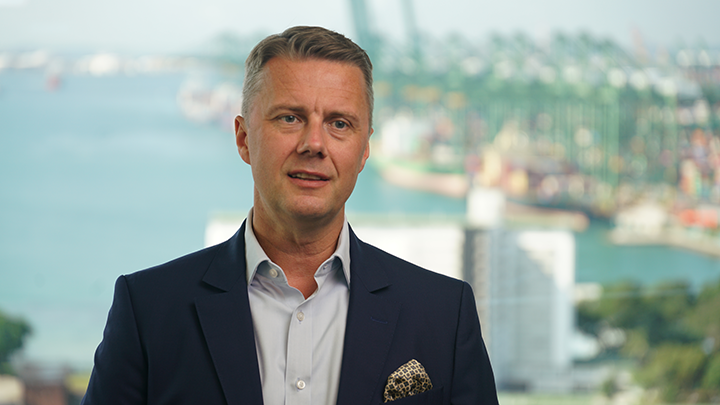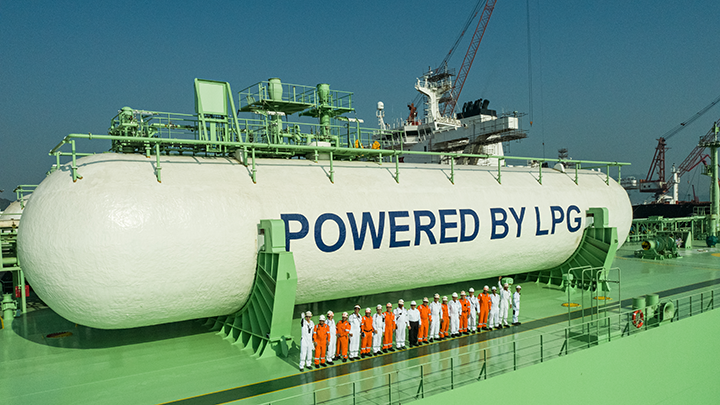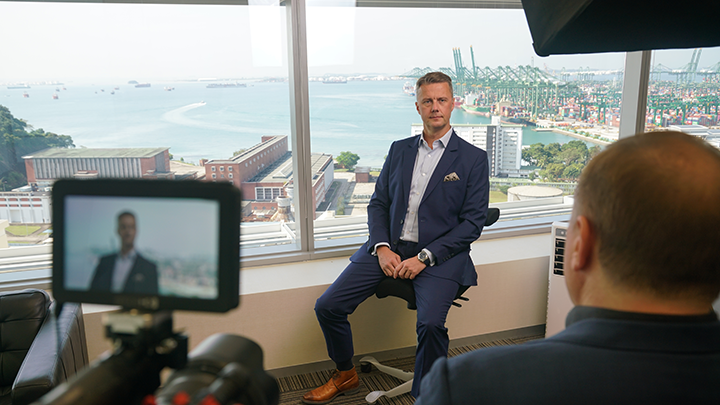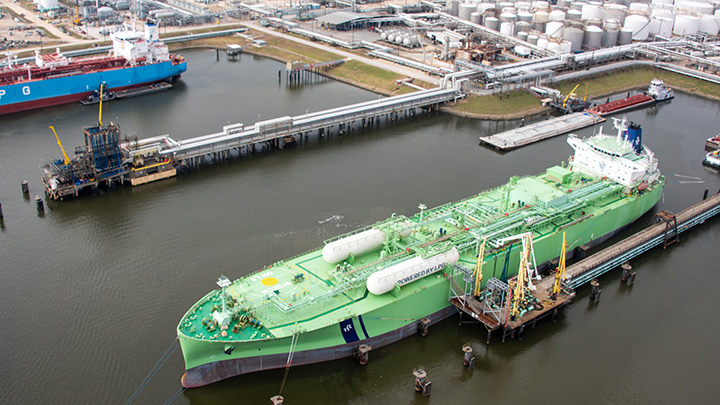BW LPG’s Pontus Berg on making waves in shipping with greener LPG dual-fuel retrofits
The average lifespan of a commercial ship is 30 years, which means the ships being built today will still be sailing the oceans in 2050. Many of these ships, however, continue to run on conventional fuels , posing a challenge for the maritime industry’s efforts to decarbonize. Discover speaks with Executive Vice President Pontus Berg of BW LPG, the world’s leading owner and operator of LPG vessels, about blazing a new trail in green shipping with their BW Gemini, the world’s first commercial vessel to be retrofitted with a two-stroke liquified petroleum gas (LPG) engine.
By Glenn van Zutphen
In October 2020, the LPG carrier BW Gemini became the first Very Large Gas Carrier (VLGC) to have its low-speed main engine converted to an LPG dual-fuel engine. Can you tell us how the project got started?
Pontus Berg: We started the project four or five years back, in preparation for the “IMO 2020”, which puts a limit on the amount of sulfur used in fuel oil on board ships. Many in the market were looking at the “scrubber” route – installing exhaust gas cleaning systems and running on currently available high sulfur fuel oil – but we decided to explore how we could run on LPG, the very fuel our carriers are transporting. We contacted MAN Energy Solutions and other partners and started in earnest on a project to retrofit VLGCs. BW Gemini was the first, but we’ve also converted BW Leo, BW Orion, and BW Libra – all four ships are running smoothly in the water with LPG as their primary fuel.

Pontus Berg, Executive Vice President, Technical and Operations of BW LPG Ltd, is pioneering a greener future for shipping in response to 21st-century challenges.
As the IMO continues to introduce measures to cut emissions, what role do you think LPG is going to play?
Without a doubt, LPG is the kickstart needed to move toward carbon-neutral fuels. When running on LPG, the LGIP engines reduce greenhouse gas emissions by 20 percent – plus, particulate matter is down 90 percent. In 2023, the Energy Efficiency Existing Ship Index (EEXI) will come into force. What this means is that vessels continuing to burn normal fuel – even when fitted with scrubbers – won’t be able to comply with emissions regulations if they sail at full speed. Vessels running on cleaner fuels such as LPG, in contrast, will be in full compliance and offer their owners and operators a distinct commercial advantage.
BW LPG has plans to retrofit 15 of its LPG carriers with the LGIP dual-fuel engine. How do retrofits compare to newbuilds?
With a retrofit, we already have the ship, so we don’t have to build it first. From an environmental perspective, the carbon dioxide (CO2) emissions are around 95–97 percent less doing a retrofit than building a new ship. Those are staggering numbers, and I think something that should be highlighted more often. Also, retrofitting takes only two months to complete versus two years for a newbuild, and it doesn’t add unneeded shipping capacity to the market.

At an advantage: Ships like BW Gemini, BW Orion, BW Leo and BW Libra running on LPG are more efficient, greener and compliant with upcoming IMO regulations such as the Energy Efficiency Existing Ship Index.

The making of a greener shipping industry: “Were pushing technology forward,” Pontus Berg tells journalist Glenn van Zutphen at BW LPG headquarters in Singapore.
The investment cost for a retrofit is significant, around USD $8–9 million per ship. How could you be so sure converting to LPG would be a sound economic investment?
Well, first of all our engine tests ended up exceeding our expectations for emissions, fuel performance and overall efficiency. In general, LPG is far more efficient compared to diesel or heavy fuel oil, around 10–12 percent in BW LPG ships. When
you look at that over time and across the fleet, the savings begin to add up. LPG propulsion also offers very compelling operational and environmental advantages in addition to the financial considerations. So even if we hadn’t been spurred
on by the IMO 2020 sulfur cap, converting to LPG would still have made sense for our business. Plus, the return on investment, when we first looked at retrofitting, was five or six years.
How much space does an LPG fuel tank need to get across the Pacific or to Europe? Does it take up a lot of cargo space?
LPG doesn't take more space than LNG (liquefied natural gas), and it's simpler to handle because it doesn't require cryogenic storage to cool the fuel to -163 °C. What ship designers have done with LNG, which is ingenious really, is to locate the fuel tanks underneath accommodation spaces and improve cargo capacity. The same possibility can also be done with an LPG tank for any other ship type.
Without a doubt, LPG is the kickstart needed to move to carbon-neutral fuels.
What about the safety factor of using LPG versus a traditional bunker fuel?
LPG wasn’t allowed in the engine room before we started this project. The issue was that LPG is heavier than air, so it flows downward and gets stuck in the bottom and in spaces where it can be a hazard. To solve this issue, we installed extra sniff
detectors and double-walled fuel pipes where you have a constant air flow on the intermediate part, which is being sniffed as well. If hydrocarbons are detected, the supply flow is automatically shut down and immediately switched to compliant
fuel, which is always available as a standby since we’re dual-fuel propelled. With these robust safety measures, we successfully secured regulatory changes from Class and Flag to accept and approve the use of LPG in the engine room.
The successful conversion of the BW Gemini received a lot of press and gained a lot of interest from other companies. With more ships running on LPG, will bunker facilities have enough fuel to service them?
This is a chicken-or-the-egg-coming-first question: Do we build bunker barges or do we convert ships? The truth is, reassuringly, straightforward. In almost every major port worldwide, LPG import or export facilities are already available. There are some 500 or 600 small-size fully-pressurized LPG vessels that are trading “last-mile” and whose bottom line will greatly benefit from a new market. It’s a matter of pricing and contracting. If you're a liner company, you say, “I’ll be here 5, 10, 20 times a year, and I want this amount of LPG available,” and it will be there.

Already most major parts around the world have LPG import or export facilities, and there are smaller, fully-pressurized LPG vessels that would be eager to find a new market providing LPG as fuel for ships.
"BW LPG’s successful retrofit of 4 vessels to run on LPG propulsion to-date, and its ambitious plan to commit 15 vessels in total, show that the use of low-emissions fuels is already an economically-viable option today. Even more importantly – next to the climate question – it also protects a shipping company’s investments. Considering a ship’s lifecycle, it is business-critical that it is equipped with technology that ensures it can sail the ocean for decades while remaining compliant with environmental regulations."
Wayne Jones OBE, Chief Sales Officer and member of the Executive Board, MAN Energy Solutions

You mentioned LPG as a needed “kickstart” to carbon-neutral fuels. Which of those fuels seems most promising?
Right now, ammonia is attracting the most attention. It’s a great hydrogen carrier and a zero-carbon fuel. So, we’re looking at it closely, dedicating resources to exploring ammonia as marine fuel with makers like MAN. It's very similar to
LPG or ethanol or methanol, but the safe, sustainable and environmentally friendly production of ammonia will be something that needs to be addressed as an industry.
BW LPG has already long been known for the efficiency of its fleet. What message do you hope the company is sending to the shipping industry and people concerned about the environment with BW Gemini and ships like it?
We welcome our industry and peers to speak with us about how retrofitting is possible for their fleet. From a commercial and operational perspective, LPG propulsion is a viable solution. We’re also playing a key part in the industry’s efforts to decarbonize. As one company, we’ve committed over USD $130 million to retrofit 15 VLGCs with LPG propulsion technology, but we can do so much more as an industry. In partnership with MAN Energy Solutions, we’re pushing technology forward towards a zero-carbon future. BW Gemini is the world’s first commercial ship to have an LPG dual-fuel engine, and we hope to kickstart a larger movement where conventional fuels are yesterday’s news. It’s a step in the right direction towards a cleaner world.
About Pontus Berg and BW LPG
Pontus Berg, Executive Vice President – Technical & Operations at BW LPG, has more than 20 years of experience in the shipping industry and holds a degree in Marine Engineering and a Chief Engineer’s License. He joined BW LPG in 2015 and set up the company’s latest green initiative to convert their VLGC engines to run on LPG. BW LPG is the world's leading owner and operator of LPG vessels, with 46 VLGCs in seven countries carrying a total capacity of over 3 million cubic meters.About the author
Glenn van Zutphen is a journalist and radio talk show host based in Singapore.
Explore more topics
MAN Energy Solutions is now Everllence.
We have adopted a new brand name and moved to a new domain: www.everllence.com. This page will also be relocated there shortly. We are working on shifting all pages to www.everllence.com.
